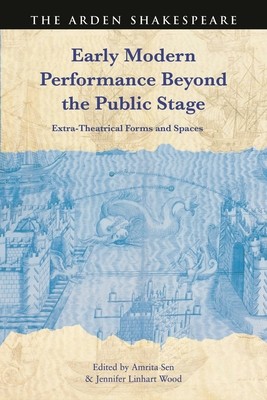
- We will send in 10–14 business days.
- Publisher: Arden Shakespeare
- ISBN-10: 1350367966
- ISBN-13: 9781350367968
- Format: 15.6 x 23.4 x 2.7 cm, kieti viršeliai
- Language: English
- SAVE -10% with code: EXTRA
Early Modern Performance Beyond the Public Stage (e-book) (used book) | bookbook.eu
Reviews
Description
Early Modern Performance Beyond the Public Stage is the first major work to explore and analyse the popular 'extra-theatrical' performances in late medieval and Renaissance England. This wider heterogeneous category of early modern performance included puppetry, fireworks shows, rope dancing, minstrelsy, performing animals, games, civic drama, court masques, university drama, morris dances, and ceremonial rituals, all taking place in a variety of venues.
The volume reveals how these extra-theatrical productions shaped urban and rural life and conveyed a sense of spectacular excess, of exceeding traditional genres, conventional modes of performance and the typical bounds of theatrical space. The spaces where medieval and early modern drama flourished include pageant carts, convents, private homes, universities, waterways, and the streets of both urban and rural communities. Much like public theatres, these performance spaces also played a pivotal role in articulating individual, communal, and national aspirations. Spanning the medieval period to the late 17th century, this volume engages with questions of spatiality, gender, religion, transcontinental exchanges, and colonialism, presenting the latest research from scholars across the globe.EXTRA 10 % discount with code: EXTRA
The promotion ends in 23d.17:53:52
The discount code is valid when purchasing from 10 €. Discounts do not stack.
- Publisher: Arden Shakespeare
- ISBN-10: 1350367966
- ISBN-13: 9781350367968
- Format: 15.6 x 23.4 x 2.7 cm, kieti viršeliai
- Language: English English
Early Modern Performance Beyond the Public Stage is the first major work to explore and analyse the popular 'extra-theatrical' performances in late medieval and Renaissance England. This wider heterogeneous category of early modern performance included puppetry, fireworks shows, rope dancing, minstrelsy, performing animals, games, civic drama, court masques, university drama, morris dances, and ceremonial rituals, all taking place in a variety of venues.
The volume reveals how these extra-theatrical productions shaped urban and rural life and conveyed a sense of spectacular excess, of exceeding traditional genres, conventional modes of performance and the typical bounds of theatrical space. The spaces where medieval and early modern drama flourished include pageant carts, convents, private homes, universities, waterways, and the streets of both urban and rural communities. Much like public theatres, these performance spaces also played a pivotal role in articulating individual, communal, and national aspirations. Spanning the medieval period to the late 17th century, this volume engages with questions of spatiality, gender, religion, transcontinental exchanges, and colonialism, presenting the latest research from scholars across the globe.

Reviews